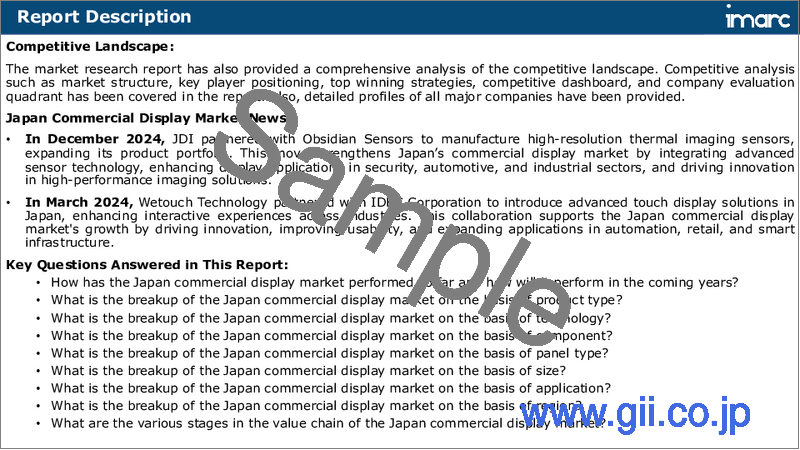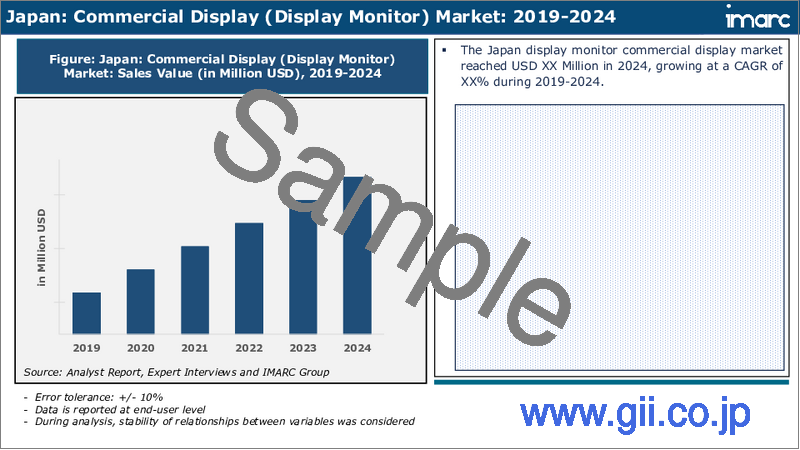|
|
市場調査レポート
商品コード
1747088
日本の業務用ディスプレイ市場:製品タイプ、技術、コンポーネント、パネルタイプ、サイズ、用途、地域別の市場規模、シェア、動向、予測、2025~2033年Japan Commercial Display Market Size, Share, Trends and Forecast by Product Type, Technology, Component, Panel Type, Size, Application, and Region, 2025-2033 |
||||||
カスタマイズ可能
|
|||||||
| 日本の業務用ディスプレイ市場:製品タイプ、技術、コンポーネント、パネルタイプ、サイズ、用途、地域別の市場規模、シェア、動向、予測、2025~2033年 |
|
出版日: 2025年06月02日
発行: IMARC
ページ情報: 英文 118 Pages
納期: 5~7営業日
|
全表示
- 概要
- 目次
日本の業務用ディスプレイ市場規模は2024年に33億7,700万米ドルに達しました。今後、IMARC Groupは、同市場が2033年には59億3,200万米ドルに達し、2025~2033年の成長率(CAGR)は6.46%になると予測しています。同市場は、デジタルサイネージ需要の高まり、有機発光ダイオード(OLED)と液晶ディスプレイ(LCD)技術の継続的な進歩、小売業と接客業での採用の増加、スマートシティ構想の拡大、eラーニング用途の拡大、企業部門の急速なデジタル変革、革新的なディスプレイソリューションに対する政府支援の急増などが牽引しています。
本レポートで扱う主要質問
- 日本の業務用ディスプレイ市場はこれまでどのように推移し、今後どのように推移するのか?
- 日本の業務用ディスプレイ市場の製品タイプ別区分は?
- 日本の業務用ディスプレイ市場の技術別区分は?
- 日本の業務用ディスプレイ市場をコンポーネント別区分は?
- 日本の業務用ディスプレイ市場のパネルタイプ別区分は?
- 日本の業務用ディスプレイ市場のサイズ別区分は?
- 日本の業務用ディスプレイ市場の用途別区分は?
- 日本の業務用ディスプレイ市場の地域別区分は?
- 日本の業務用ディスプレイ市場のバリューチェーンにおける様々なステージとは?
- 日本の業務用ディスプレイの主要な促進要因と課題は?
- 日本の業務用ディスプレイ市場の構造と主要参入企業は?
- 日本の業務用ディスプレイ市場における競合の程度は?
目次
第1章 序文
第2章 調査範囲と調査手法
- 調査の目的
- ステークホルダー
- データソース
- 市場推定
- 調査手法
第3章 エグゼクティブサマリー
第4章 日本の業務用ディスプレイ市場-イントロダクション
- 概要
- 市場力学
- 産業動向
- 競合情報
第5章 日本の業務用ディスプレイ市場情勢
- 過去と現在の市場動向(2019~2024年)
- 市場予測(2025~2033年)
第6章 日本の業務用ディスプレイ市場-製品タイプ別内訳
- デジタルサイネージ
- ディスプレイモニター
- ディスプレイテレビ
第7章 日本の業務用ディスプレイ市場-技術別内訳
- 液晶
- LED
- その他
第8章 日本の業務用ディスプレイ市場-コンポーネント別内訳
- ハードウェア
- ソフトウェア
- サービス
第9章 日本の業務用ディスプレイ市場-パネルタイプ別内訳
- フラットパネル
- 曲面パネル
- その他
第10章 日本の業務用ディスプレイ市場-サイズ別内訳
- 32インチ以下
- 32~52インチ
- 52~75インチ
- 75インチ以上
第11章 日本の業務用ディスプレイ市場-用途別内訳
- 小売
- ホスピタリティ
- エンターテインメント
- スタジアムと遊び場
- 企業
- 銀行業務
- ヘルスケア
- 教育
- 輸送
第12章 日本の業務用ディスプレイ市場-競合情勢
- 概要
- 市場構造
- 市場企業のポジショニング
- 主要成功戦略
- 競合ダッシュボード
- 企業評価象限
第13章 主要企業のプロファイル
第14章 日本の業務用ディスプレイ市場-産業分析
- 促進要因・抑制要因・機会
- ポーターのファイブフォース分析
- バリューチェーン分析
第15章 付録
The Japan commercial display market size reached USD 3,377.0 Million in 2024. Looking forward, IMARC Group expects the market to reach USD 5,932.0 Million by 2033, exhibiting a growth rate (CAGR) of 6.46% during 2025-2033. The market is driven by rising demand for digital signage, continuous advancements in Organic Light-Emitting Diode (OLED) and Liquid Crystal Display (LCD) technology, increasing adoption in retail and hospitality, growing smart city initiatives, expanding e-learning applications, rapid corporate sector digital transformation, and surging government support for innovative display solutions.
Japan Commercial Display Market Trends:
Growing Adoption of Digital Signage in Retail and Hospitality
The Japan commercial display market is witnessing a significant rise in the adoption of digital signage across the retail and hospitality sectors. Businesses in retail now employ interactive displays along with high-resolution technology to achieve customer involvement through targeted promotions and organized store routing. For instance, in early 2024, 7-Eleven convenience stores in Japan integrated AI-powered vision detection technology to optimize in-store advertising, enhancing customer engagement through personalized promotions and dynamic content displays. Moreover, the hospitality sector, including hotels and restaurants, utilizes digital displays primarily for self-service kiosks, digital menus, and interactive customer engagement technologies. The market is experiencing growing demand as businesses prioritize customer-centric marketing strategies, while the expansion of smart technology accelerates innovation and enhances engagement across industries. Furthermore, the developing smart cities, together with their active urbanization program, speed up the usage of digital signage throughout public areas and transportation centers, and entertainment facilities. The developments in OLED and LCD technology have led to commercial displays obtaining thinner designs, higher energy efficiency, and better image quality, which drives organizations to spend on display system modernization for improved customer interaction and operational effectiveness. As a result, this trend is significantly boosting the Japan commercial display market share.
Expansion of Smart Conference and Education Displays
The Japan commercial display market is witnessing a growing requirement for intelligent conference and education displays, which is driving the Japan commercial display market growth. In addition to this, businesses collaborating with educational institutions are driving digital transformation, increasing demand for interactive whiteboards, large-format touchscreen displays, and video conferencing solutions. Moreover, the hybrid workplace demands corporate spaces to install high-quality artificial intelligence (AI)-enabled displays that allow remote collaboration and hybrid meetings. For example, in October 2024, Lenovo introduced AI-driven devices and solutions to enhance meeting rooms, boosting productivity, security, and collaboration for both in-person and virtual work environments, driving demand for intelligent commercial displays. Concurrently, educational facilities deploy smart boards as well as digital classrooms to create better interactive educational environments. Modernization programs launched by the Japanese government, along with expanding e-learning usage, are also spurring the adoption of smart education displays. Furthermore, the combination of 5G technology and cloud-based solutions has enhanced smart display connectivity along with functionality that expands their application range from business to academic use. As a result, manufacturers now concentrate their efforts on innovation because they aim to deliver features such as multi-touch capabilities, real-time content sharing, and AI-driven analytics to satisfy changing sector requirements, thus enhancing the Japan commercial display market outlook.
Japan Commercial Display Market Segmentation:
Product Type Insights:
- Digital Signage
- Display Monitor
- Display TV's
Technology Insights:
- LCD
- LED
- Others
Component Insights:
- Hardware
- Software
- Services
Panel Type Insights:
- Flat Panel
- Curved Panel
- Other
Size Insights:
- Below 32 inches
- 32 to 52 inches
- 52 to 75 inches
- Above 75 inches
Application Insights:
- Retail
- Hospitality
- Entertainment
- Stadiums and Playgrounds
- Corporate
- Banking
- Healthcare
- Education
- Transportation
Competitive Landscape:
The market research report has also provided a comprehensive analysis of the competitive landscape. Competitive analysis such as market structure, key player positioning, top winning strategies, competitive dashboard, and company evaluation quadrant has been covered in the report. Also, detailed profiles of all major companies have been provided.
Key Questions Answered in This Report:
- How has the Japan commercial display market performed so far and how will it perform in the coming years?
- What is the breakup of the Japan commercial display market on the basis of product type?
- What is the breakup of the Japan commercial display market on the basis of technology?
- What is the breakup of the Japan commercial display market on the basis of component?
- What is the breakup of the Japan commercial display market on the basis of panel type?
- What is the breakup of the Japan commercial display market on the basis of size?
- What is the breakup of the Japan commercial display market on the basis of application?
- What is the breakup of the Japan commercial display market on the basis of region?
- What are the various stages in the value chain of the Japan commercial display market?
- What are the key driving factors and challenges in the Japan commercial display?
- What is the structure of the Japan commercial display market and who are the key players?
- What is the degree of competition in the Japan commercial display market?
Table of Contents
1 Preface
2 Scope and Methodology
- 2.1 Objectives of the Study
- 2.2 Stakeholders
- 2.3 Data Sources
- 2.3.1 Primary Sources
- 2.3.2 Secondary Sources
- 2.4 Market Estimation
- 2.4.1 Bottom-Up Approach
- 2.4.2 Top-Down Approach
- 2.5 Forecasting Methodology
3 Executive Summary
4 Japan Commercial Display Market - Introduction
- 4.1 Overview
- 4.2 Market Dynamics
- 4.3 Industry Trends
- 4.4 Competitive Intelligence
5 Japan Commercial Display Market Landscape
- 5.1 Historical and Current Market Trends (2019-2024)
- 5.2 Market Forecast (2025-2033)
6 Japan Commercial Display Market - Breakup by Product Type
- 6.1 Digital Signage
- 6.1.1 Overview
- 6.1.2 Historical and Current Market Trends (2019-2024)
- 6.1.3 Market Forecast (2025-2033)
- 6.2 Display Monitor
- 6.2.1 Overview
- 6.2.2 Historical and Current Market Trends (2019-2024)
- 6.2.3 Market Forecast (2025-2033)
- 6.3 Display TVs
- 6.3.1 Overview
- 6.3.2 Historical and Current Market Trends (2019-2024)
- 6.3.3 Market Forecast (2025-2033)
7 Japan Commercial Display Market - Breakup by Technology
- 7.1 LCD
- 7.1.1 Overview
- 7.1.2 Historical and Current Market Trends (2019-2024)
- 7.1.3 Market Forecast (2025-2033)
- 7.2 LED
- 7.2.1 Overview
- 7.2.2 Historical and Current Market Trends (2019-2024)
- 7.2.3 Market Forecast (2025-2033)
- 7.3 Others
- 7.3.1 Historical and Current Market Trends (2019-2024)
- 7.3.2 Market Forecast (2025-2033)
8 Japan Commercial Display Market - Breakup by Component
- 8.1 Hardware
- 8.1.1 Overview
- 8.1.2 Historical and Current Market Trends (2019-2024)
- 8.1.3 Market Forecast (2025-2033)
- 8.2 Software
- 8.2.1 Overview
- 8.2.2 Historical and Current Market Trends (2019-2024)
- 8.2.3 Market Forecast (2025-2033)
- 8.3 Services
- 8.3.1 Overview
- 8.3.2 Historical and Current Market Trends (2019-2024)
- 8.3.3 Market Forecast (2025-2033)
9 Japan Commercial Display Market - Breakup by Panel Type
- 9.1 Flat Panel
- 9.1.1 Overview
- 9.1.2 Historical and Current Market Trends (2019-2024)
- 9.1.3 Market Forecast (2025-2033)
- 9.2 Curved Panel
- 9.2.1 Overview
- 9.2.2 Historical and Current Market Trends (2019-2024)
- 9.2.3 Market Forecast (2025-2033)
- 9.3 Other
- 9.3.1 Historical and Current Market Trends (2019-2024)
- 9.3.2 Market Forecast (2025-2033)
10 Japan Commercial Display Market - Breakup by Size
- 10.1 Below 32 inches
- 10.1.1 Overview
- 10.1.2 Historical and Current Market Trends (2019-2024)
- 10.1.3 Market Forecast (2025-2033)
- 10.2 32 to 52 inches
- 10.2.1 Overview
- 10.2.2 Historical and Current Market Trends (2019-2024)
- 10.2.3 Market Forecast (2025-2033)
- 10.3 52 to 75 inches
- 10.3.1 Overview
- 10.3.2 Historical and Current Market Trends (2019-2024)
- 10.3.3 Market Forecast (2025-2033)
- 10.4 Above 75 inches
- 10.4.1 Overview
- 10.4.2 Historical and Current Market Trends (2019-2024)
- 10.4.3 Market Forecast (2025-2033)
11 Japan Commercial Display Market - Breakup by Application
- 11.1 Retail
- 11.1.1 Overview
- 11.1.2 Historical and Current Market Trends (2019-2024)
- 11.1.3 Market Forecast (2025-2033)
- 11.2 Hospitality
- 11.2.1 Overview
- 11.2.2 Historical and Current Market Trends (2019-2024)
- 11.2.3 Market Forecast (2025-2033)
- 11.3 Entertainment
- 11.3.1 Overview
- 11.3.2 Historical and Current Market Trends (2019-2024)
- 11.3.3 Market Forecast (2025-2033)
- 11.4 Stadiums and Playgrounds
- 11.4.1 Overview
- 11.4.2 Historical and Current Market Trends (2019-2024)
- 11.4.3 Market Forecast (2025-2033)
- 11.5 Corporate
- 11.5.1 Overview
- 11.5.2 Historical and Current Market Trends (2019-2024)
- 11.5.3 Market Forecast (2025-2033)
- 11.6 Banking
- 11.6.1 Overview
- 11.6.2 Historical and Current Market Trends (2019-2024)
- 11.6.3 Market Forecast (2025-2033)
- 11.7 Healthcare
- 11.7.1 Overview
- 11.7.2 Historical and Current Market Trends (2019-2024)
- 11.7.3 Market Forecast (2025-2033)
- 11.8 Education
- 11.8.1 Overview
- 11.8.2 Historical and Current Market Trends (2019-2024)
- 11.8.3 Market Forecast (2025-2033)
- 11.9 Transportation
- 11.9.1 Overview
- 11.9.2 Historical and Current Market Trends (2019-2024)
- 11.9.3 Market Forecast (2025-2033)
12 Japan Commercial Display Market - Competitive Landscape
- 12.1 Overview
- 12.2 Market Structure
- 12.3 Market Player Positioning
- 12.4 Top Winning Strategies
- 12.5 Competitive Dashboard
- 12.6 Company Evaluation Quadrant
13 Profiles of Key Players
- 13.1 Company A
- 13.1.1 Business Overview
- 13.1.2 Products Offered
- 13.1.3 Business Strategies
- 13.1.4 SWOT Analysis
- 13.1.5 Major News and Events
- 13.2 Company B
- 13.2.1 Business Overview
- 13.2.2 Products Offered
- 13.2.3 Business Strategies
- 13.2.4 SWOT Analysis
- 13.2.5 Major News and Events
- 13.3 Company C
- 13.3.1 Business Overview
- 13.3.2 Products Offered
- 13.3.3 Business Strategies
- 13.3.4 SWOT Analysis
- 13.3.5 Major News and Events
- 13.4 Company D
- 13.4.1 Business Overview
- 13.4.2 Products Offered
- 13.4.3 Business Strategies
- 13.4.4 SWOT Analysis
- 13.4.5 Major News and Events
- 13.5 Company E
- 13.5.1 Business Overview
- 13.5.2 Products Offered
- 13.5.3 Business Strategies
- 13.5.4 SWOT Analysis
- 13.5.5 Major News and Events
14 Japan Commercial Display Market - Industry Analysis
- 14.1 Drivers, Restraints, and Opportunities
- 14.1.1 Overview
- 14.1.2 Drivers
- 14.1.3 Restraints
- 14.1.4 Opportunities
- 14.2 Porters Five Forces Analysis
- 14.2.1 Overview
- 14.2.2 Bargaining Power of Buyers
- 14.2.3 Bargaining Power of Suppliers
- 14.2.4 Degree of Competition
- 14.2.5 Threat of New Entrants
- 14.2.6 Threat of Substitutes
- 14.3 Value Chain Analysis





